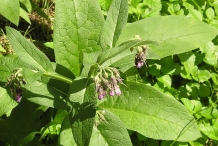Plant
The plant of Comfrey grows up to 30 to 120 cm high. Comfrey is a large and black turnip like root. The plant has broad leaves and flowers in bell shaped of purple or cream. The flower blooms during mid-summer. It has erect and stiff haired stem. Inherent to Europe, it grows in damp and grassy places and could be locally found in Britain and Ireland on ditches and river banks.
Traditional uses
Comfrey is used as an aid for humans. It is used as a tea or vegetables by humans. In herbal medicine, it was used for treating tendon damage, broken bones, lung congestion, ulcerations in gastrointestinal tract, joint inflammation, lung congestion and also promotes wound healing.
- It is used topically to treat wounds.
- Comfrey is useful in healing sprains, bruises and promotes healing of bones.
- Externally, roots is used to gargle or mouthwash for gum diseases, strep throat and pharyngitis.
- The internal use of roots is helpful for gastrointestinal ulcers and gastritis.
- Roots are used as an aid for pleuritis, rheumatism and diarrhea in folk medicine.
- It is used to treat gout and arthritis.
- Its ointments help to heal, ligaments, pulled muscles, bruises, strains, sprains, fractures and osteoarthritis.
- It is also useful for stomach problems.
Precautions
- It should not be applied to the broken skin or wounds.
- Not to be used by pregnant and lactation women.
- The people with liver problems should use it with caution.
- It might cause abdominal pain, loss of appetite and vomiting.
- It should not be combined with the herb that possesses pyrrolizidine alkaloids.
- It has compounds which are harmful for liver and might cause liver cancer.
How to Eat
- Sometimes it is used as an ingredient in salads and soups.
- Young leaves are consumed raw or cooked.
- Finely chop it and add it to salads.
- The shoots (young) are used as a substitute for asparagus.
- The dried leaves and roots are used as tea.
Other Facts
When dried, the root becomes slimy and horn like.
References:
http://davesgarden.com/guides/pf/go/317/
http://www.pfaf.org/user/Plant.aspx?LatinName=Symphytum+officinale
https://www.mskcc.org/cancer-care/integrative-medicine/herbs/comfrey
http://www.missouribotanicalgarden.org/PlantFinder/PlantFinderDetails.aspx?kempercode=b472
http://www.floracatalana.net/symphytum-officinale-l-
http://www.umm.edu/health/medical/altmed/herb/comfrey
https://www.drugs.com/npp/comfrey.html
https://www.botanical.com/botanical/mgmh/c/comfre92.html
Comments
| Comfrey Quick Facts | |
|---|---|
| Name: | Comfrey |
| Scientific Name: | Symphytum officinale |
| Origin | Comfrey is native to Europe and temperate Asia and got naturalized in U.S. |
| Name | Comfrey |
|---|---|
| Scientific Name | Symphytum officinale |
| Native | Comfrey is native to Europe and temperate Asia and got naturalized in U.S. |
| Common/English Name | Ass Ear, Blackwort, Black Root, Boneset, Consound, Bruisewort, Gum Plant, Knitback, Healing Herb, Knitbone, Slippery Root, Salsify, Wallwort, Boneset, Consolida, Common comfrey |
| Name in Other Languages | German: Beinwell, Gewöhnlicher Beinwell, Echter Beinwell, Gemeiner Beinwell; Arabic: Sanfītūn, Senfeytewn mekhezney Catalan: Orella d’ase, Consolda major, Nualós, Orella d’ase; Chinese: Jù hé cǎo (聚合草); Czech: Kostival lékařský; Danish: Læge-Kulsukker, Kulsukkerrod; Dutch: Gewone smeerwortel; English: Boneset, Common comfrey, Comfrey, Consound, Knitbone, Healing herb, Slippery root, Medicinal comfrey, Wild comfrey; Finnish: Mustajuuri, Rohtoraunioyrtti, Raunioyrtti, Rohto-raunioyrtti; French: Consoude officinale, Oreille de vache, Grande consoude; German: Echter Beinwell, Gemeiner Beinwell, Echte Wallwurz, Gewöhnlicher Beinwell, Schwarzwurzel, Große Wallwurz, Wilder Komfrey; Hungarian: Fekete nadálytő; Italian: Orecchia d’asino, Consolida maggiore; Japanese: Hireharisō (ヒレハリソウ), Hireharisou (鰭玻璃草) , Konfurī (コンフリー); Korean: Keom peu li (컴프리); Marathi: Sankuutan (संकूतुन); Polish: Żywokost lekarski; Portuguese: Confrei, Consolida-maior, Consolda-maior, Orelhas-de-asno, Grande-consolda; Russian: Okopnik lekarstvennyj (копник лекарственный ); Slovakian: Kostihoj lekársky; Slovenian: Navadni gabez, Gabez navadni; Spanish: Consuelda, Consuelda mayor, Consuelda blanca, Hierba de las cortaduras, Sínfito mayor, Oreja de asno; Swedish: Äkta vallört; Turkish: Kafes otu, Mayasılotu, Karakafes, Merkep kulağı; Occitan: Èrba de la còpa; |
| Plant Growth Habit | Perennial |
| Soil | Moist |
| Plant Size | Height: 30 to 120 cm |
| Root | Branched, fusiform, fleshy, oblong, perennial, black outside and white inside |
| Stem | Erect, stiff haired |
| Leaf | Wrinkly, roughly pubescent, ovate to lanceolate |
| Flowering Season | Late Spring or Early Summer, Mid-Summer |
| Flower | Dull purple or violet, showy |
| Plant parts used | Leaf, root, rhizome |








